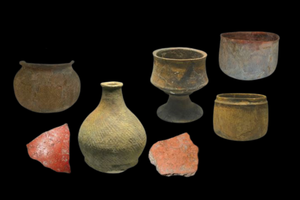EARTHENWARE POTTERY REMAINS one of the most significant indicators of technological and cultural development in prehistoric societies, particularly during the Neolithic period. In Malaysia, the Neolithic culture is believed to have begun around 4,000 to 4,500 years ago, and is represented by more than 100 archaeological sites across the country. This culture is characterised by features such as extended burials and artefacts like earthenware pottery, polished stone tools (adze), bark beaters as well as stone and shell bracelets. Broadly, the Neolithic culture in Malaysia shares many similarities with those found in other parts of Southeast Asia.
Neolithic sites in Malaysia are primarily found in caves and rock shelters, while others are found at open-air sites along riverbanks. The former were commonly used as habitation areas or for burial purposes; the latter, often situated near water sources, tended to serve as habitation areas, indicating that these communities’ strategic settlement patterns were linked to resource availability. These sites often reveal evidence and remains of Neolithic culture in the upper layers of the site floor in the form of pottery shards, stone tools, bark beaters, food remains and sometimes, extended burials.






